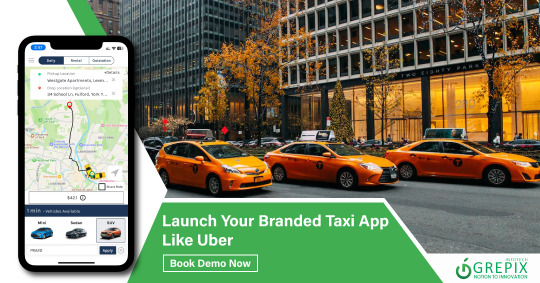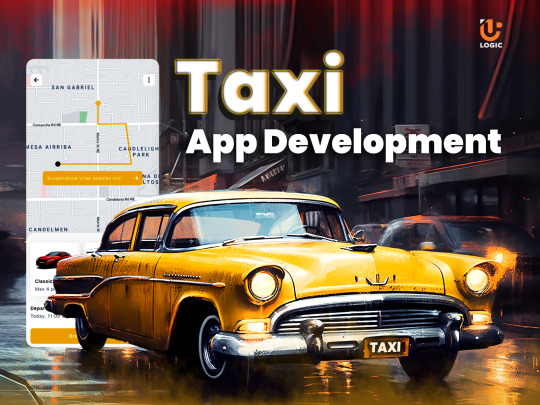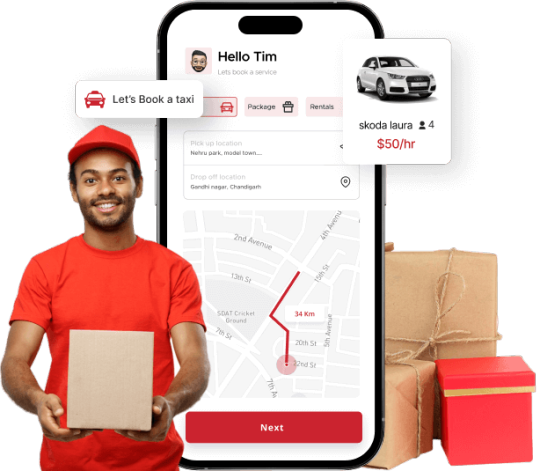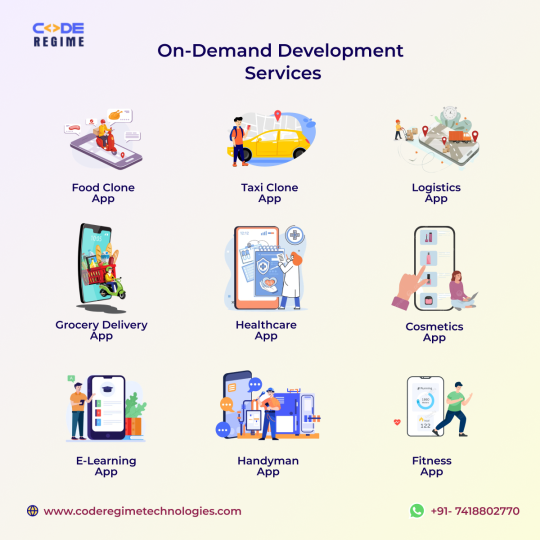#taxi App Development
Explore tagged Tumblr posts
Text

Techanic Infotech is a leading dating app development company. Hire dating app developers to get unmatched dating app development services.
#business#design#web development#dating app development#taxi app development#E-Commerce Development Company
2 notes
·
View notes
Text
How to Build a Taxi Booking App Like inDriver, OLA, and Uber Clone App

In today's fast-paced world, convenience is key when it comes to transportation. Taxi booking apps like inDriver, OLA, and Uber have revolutionized the way people get around. If you're looking to join the ride-hailing industry and create your own successful taxi booking app, you're in the right place. In this article, we'll guide you through the process step by step.
Understanding the Market
Before diving into app development, it's crucial to conduct thorough market research. This research will help you identify your target audience, understand their needs, and analyze your competitors. Here's how you can get started:
Market Analysis
Begin by researching the ride-hailing market in your target region. Identify key players, market trends, and potential gaps in services.
Target Audience
Determine your app's target audience. Are you catering to everyday commuters, tourists, or a specific niche? Understanding your users' preferences is essential.
Building the App
Now that you have a clear understanding of the market, it's time to start building your taxi booking app. This process involves several steps:
Feature List
Create a detailed list of features your app will offer. This should include user registration, driver profiles, GPS tracking, payment processing, and more.
Technology Stack
Choose the right technology stack for your app. Consider whether you want to build a native app for iOS and Android or opt for a cross-platform solution.
Design and User Experience
Invest in an intuitive and user-friendly design. The app's interface should be easy to navigate for both passengers and drivers.
Development Team
Assemble a skilled development team or hire a reputable app development company to bring your vision to life.
Testing and Quality Assurance
Thoroughly test the app for bugs, glitches, and security vulnerabilities. Ensure it functions seamlessly before launch.
Deployment
Release your app on app stores like Google Play Store and Apple App Store. Optimize your app listing with relevant keywords and appealing visuals.
Legal and Regulatory Considerations
Compliance with local regulations is essential in the ride-hailing industry. Be sure to:
Obtain Necessary Permits
Check with local authorities to understand the permits and licenses required to operate a taxi booking service.
Data Privacy
Implement robust data privacy measures to protect user information and comply with data protection laws.
Marketing and Promotion
Once your app is live, you'll need to market it effectively to attract users:
Digital Marketing
Utilize digital marketing strategies like search engine optimization (SEO), social media marketing, and online advertising to reach a wider audience.
Incentives and Referral Programs
Encourage users to refer friends and family by offering incentives and referral bonuses.
Scaling and Expansion
As your app gains popularity, consider expanding your services:
Geographic Expansion
Explore opportunities to launch your app in neighboring cities or countries.
Additional Services
Introduce additional services such as food delivery, package delivery, or carpooling to diversify your offerings.
Conclusion
Building a taxi booking app like inDriver, OLA, and Uber requires careful planning, a dedicated team, and a commitment to delivering a top-notch user experience. By following the steps outlined in this article, you can embark on your journey to creating a successful taxi booking app.
FAQs
How much does it cost to develop a taxi booking app?
The cost of app development can vary significantly depending on factors like features, complexity, and the development team's rates. It's best to get a personalized quote from app developers.
Is it essential to have a mobile app for both iOS and Android?
While having apps for both platforms is ideal for reaching a broader audience, you can start with one platform and expand later based on user demand.
What is the key to attracting drivers to my platform?
Offer competitive commissions, a user-friendly driver app, and efficient payment processing to attract and retain drivers.
How can I ensure passenger safety in my app?
Implement background checks for drivers, allow users to share ride details with friends, and incorporate a ratings and reviews system for drivers.
What are some emerging trends in the ride-hailing industry?
Some emerging trends include electric and autonomous vehicles, eco-friendly options, and improved AI for better route optimization and user experience.
4 notes
·
View notes
Text

Ready to accelerate your #taxi business? Look no further! Uplogic Technologies, provide up to snuff #TaxiAppDevelopment services.
To Know More: https://www.uplogictech.com/taxi-app-development-company
#taxi app development#taxi app solution#taxiappdevelopmentcompany#business#startup#mobile app development
2 notes
·
View notes
Text
Taxi Booking App Development - India App Developer

For taxi drivers, booking apps can help optimize their routes, minimize downtime, and increase their earnings. The app's algorithms can match drivers with nearby passengers, reducing empty miles and maximizing their time on the road. here we mentioned many reason why Taxi Booking App development is important.
#taxi App Development#Taxi booking App Development#taxi app development cost#taxi booking app development cost in india
4 notes
·
View notes
Text
The Surprising 😲 Truth About Taxi 🚕 App Development Costs 💲 - Revealed By CTO
Are you an entrepreneur planning to build a taxi app? 💼💻 Before you begin, check out this video where a CTO breaks down the development costs! 💰
youtube
3 notes
·
View notes
Text

Why Choose Us? ✅ Custom-built solutions for diverse industries ✅ AI & automation for enhanced efficiency ✅ Secure & scalable architecture ✅ Cross-platform compatibility (Android, iOS, Web) ✅ 24/7 technical support 📩 Get in Touch: 📲 Take your business to the next level with an on-demand app!
#tokyo#branding#ondemandapps#mobile app developers#customappdevelopment#taxi app development#food app development company#hybrid app development#ios app development#flutter app development#android app development
0 notes
Text
Taxi Booking App Development Company in India
Today's digital industry the demand of the taxi booking app and website is increase day by day. Users requirement is increased to develop taxi booking app. So we can understand the different requirement of the customers or businesses. mSquare have a dedicated expert team to deeply study of your specific requirement. we identify your the goals that you want to achieve through the taxi app development.
For More Information Visit Our Website : https://msquaretech.in/taxi_booking_app_development_company

#On Demand Taxi Booking App Development Company#Taxi Booking App Development Company in India#Taxi Booking App Development Cost#Taxi App Development#Cab Booking App Development#Taxi App Development Company in India#Top Taxi Booking App Development#Taxi Booking App Development Service#On-Demand Taxi Booking App Development Company#Taxi App Development Solutions#Best Taxi Booking App Development Company#Taxi Booking App Development Services Company#Taxi App Development Company
0 notes
Text
Revolutionizing Transportation: The Rise of Taxi App Development
The way we hail a ride has drastically changed in recent years. Gone are the days of standing on street corners, desperately waving for a cab. Today, with a few taps on our smartphones, a ride arrives at our doorstep. This transformation is powered by sophisticated mobile applications, and behind these apps are dedicated taxi app development companies. The demand for efficient and convenient transportation solutions has fueled the growth of the on-demand economy, making taxi booking app development a lucrative and essential service.
Visit Us:
#Taxi App Development#Taxi Booking App Development Company#ride hailing app development#taxi app development company in india#taxi app development services#Taxi Booking App Development Company in India#ride sharing app development Company
1 note
·
View note
Text
The Future of Transportation: Taxi App Solutions for Businesses

The future of transportation lies in advanced taxi app development. Learn how cutting-edge technology can empower businesses with better efficiency and customer satisfaction.
0 notes
Text
Developing a Reliable Taxi app Architecture
The on-demand taxi app industry has revolutionized urban mobility, with leaders like Uber, Ola, and Gojek transforming transportation. Gone are the days of waiting for buses or struggling with parking. Whether heading to a wedding, a business meeting, or an intercity trip, these apps provide a seamless experience with easy signups, intuitive interfaces, and quick ride confirmations, benefiting both riders and drivers.

As a leading taxi app development company in India, TechTose understands the criticality of a robust and scalable architecture for a successful taxi app. Handling surging user traffic, ensuring real-time updates, and maintaining high availability are paramount for a seamless user experience.
This blog delves into the key technical considerations for developing a scalable and reliable taxi app architecture.
1. Microservices Architecture
Decoupling: Break down the app into smaller, independent services (e.g., user management, ride requests, driver location, payments). This allows for independent scaling, development, and deployment.
Flexibility: Each service can be developed and deployed independently using different technologies and languages, providing greater flexibility.
Fault Isolation: If one service fails, it won't bring down the entire system.
Scalability: Scale individual services based on demand, optimizing resource utilization.
2. Cloud Computing
Scalability and Elasticity: Leverage cloud platforms like AWS, Azure, or GCP to easily scale resources up or down based on demand.
High Availability: Utilize redundant infrastructure and load balancing to ensure continuous service availability.
Global Reach: Cloud providers offer global infrastructure, enabling you to serve users worldwide with low latency.
3. Real-time Data Streaming
Efficient Communication: Utilize technologies like Kafka or Pub/Sub to efficiently handle real-time data streams, such as ride requests, driver locations, and status updates.
Low Latency: Ensure minimal delays in processing and delivering crucial information, such as driver availability and estimated arrival times.
4. NoSQL Databases
High Scalability: Employ NoSQL databases like MongoDB or Cassandra to handle the high volume and velocity of data generated by a taxi app.
Flexibility: NoSQL databases offer flexibility in data modeling and can easily accommodate changing data structures.
5. Caching Mechanisms
Reduced Database Load: Implement caching mechanisms like Redis or Memcached to store frequently accessed data in memory.
Improved Response Times: Serve cached data directly to users, significantly reducing response times and improving overall performance.
6. API Gateways
Centralized Control: Utilize API gateways like Kong or Apigee to manage and secure all API traffic.
Traffic Management: Implement rate limiting, request routing, and authentication/authorization policies at the gateway level.
Monitoring and Analytics: Gain insights into API usage patterns and identify potential performance bottlenecks.
7. Continuous Integration and Continuous Delivery (CI/CD)
Faster Releases: Automate the build, test, and deployment processes to quickly release new features and bug fixes.
Reduced Errors: Minimize human error and ensure consistent quality across deployments.
8. Robust Monitoring and Logging
Proactive Issue Detection: Implement comprehensive monitoring and logging systems to track system performance, identify potential issues, and quickly diagnose problems.
Data-Driven Decisions: Analyze log data to gain valuable insights into user behavior, system performance, and areas for improvement.
Conclusion
By carefully considering these technical aspects, TechTose can develop a robust, scalable, and reliable taxi app architecture that can handle the demands of a growing user base and ensure a smooth and enjoyable user experience.
0 notes
Text

Cloud-based taxi dispatch software boosts efficiency, reduces costs, and improves communication. Upgrade to a cloud solution today for better scalability and a seamless customer experience!
0 notes
Text
How Parcel Delivery Apps Are Revolutionizing Logistics

I’ve always been fascinated by how technology keeps reshaping the way businesses operate, especially in the logistics world. Parcel delivery app development is one of those innovations that’s truly a game-changer. It’s incredible how these apps make managing deliveries smoother, faster, and more efficient for everyone—from big delivery companies to small stores. Let me share how these apps are revolutionizing logistics and why they’re worth considering for your business.
Simplifying Delivery Operations
Running a delivery service used to mean lots of paperwork, countless phone calls, and the constant worry of keeping customers happy. But with the rise of parcel delivery app development, everything is becoming much simpler. These apps let businesses organize deliveries with just a few taps, offering features like real-time tracking, route optimization, and instant notifications. I think about how much time this saves, especially for small businesses juggling multiple tasks at once.
Improving Customer Satisfaction
One of my favorite things about parcel delivery apps is how they enhance the customer experience. Imagine being able to track your package in real-time or receive updates about delivery times. Customers love transparency and efficiency, and these apps deliver both. If you’re running a small store or managing deliveries for a business, having a parcel delivery app can boost your customer satisfaction and loyalty.
Combining Taxi and Parcel Delivery
Now, let’s talk about something even more exciting: combining taxi booking app development with parcel delivery. Did you know some apps now allow taxis to double as delivery vehicles? It’s a brilliant way to maximize resources and reduce downtime for drivers. Taxi app development is branching out, offering multi-purpose solutions that can cater to both passenger rides and parcel deliveries. This approach is perfect for businesses that want a cost-effective way to manage local deliveries.
Expanding Business Opportunities
For small businesses and stores, a parcel delivery app opens up new possibilities. You don’t need a massive fleet of vehicles to offer delivery services anymore. With the right app, you can partner with local drivers or courier services to fulfill orders. It’s a flexible, scalable solution that can grow with your business.
Staying Ahead with Innovation
The logistics industry is moving fast, and staying ahead means embracing new technologies. Whether you’re considering parcel delivery app development or exploring options for taxi app development, having the right tools can set you apart from competitors. It’s all about making your services more efficient and customer-friendly.
Final Thoughts
In today’s world, convenience is king. Parcel delivery apps are revolutionizing logistics by making deliveries more efficient, cost-effective, and customer-focused. Whether you’re running a parcel delivery company, a local store, or a small business looking to expand, these apps are worth exploring. And who knows? Maybe integrating taxi booking app development into your strategy could be your next big move!
I’d love to hear your thoughts. How do you see parcel delivery and taxi app development shaping your business in the future? Let’s start a conversation!
0 notes
Text
Expert Taxi App Development: Your Vision, Our Expertise
Partner with us to develop a cutting-edge taxi booking app development that delivers exceptional user experiences. Our team specializes in innovative design and development.
0 notes
Text

Why Choose Us? ✅ Custom-built solutions for diverse industries ✅ AI & automation for enhanced efficiency ✅ Secure & scalable architecture ✅ Cross-platform compatibility (Android, iOS, Web) ✅ 24/7 technical support 📩 Get in Touch: 📲 Take your business to the next level with an on-demand app!
#Singapore business#custom mobile app development company#branding#marketing#appdevelopment#ondemandapps#taxi app development#food app development company#handymanapp#serviceapp#grocery app#logistics app development
0 notes
Text
Taxi Booking App Development Company
Today's digital industry the demand of the taxi booking app and website is increase day by day. Users requirement is increased to develop taxi booking app. So we can understand the different requirement of the customers or businesses. mSquare have a dedicated expert team to deeply study of your specific requirement. we identify your the goals that you want to achieve through the taxi app development.
For More Information Visit Our website : https://msquaretech.in/taxi_booking_app_development_company

#On Demand Taxi Booking App Development Company#Taxi Booking App Development Company in India#Taxi Booking App Development Cost#Taxi App Development#Cab Booking App Development#Taxi App Development Company in India#Top Taxi Booking App Development#Taxi Booking App Development Service#On-Demand Taxi Booking App Development Company#Taxi App Development Solutions#Best Taxi Booking App Development Company#Taxi Booking App Development Services Company#Taxi App Development Company
0 notes
Text
Taxi App with Driver Ratings and Feedback Features

A screen displaying the rating system that allows passengers to rate drivers and provide feedback, improving service quality in taxi app development services.
0 notes